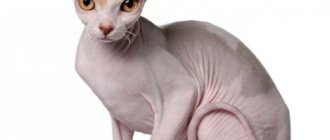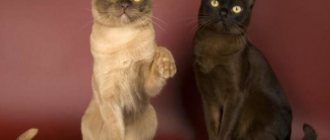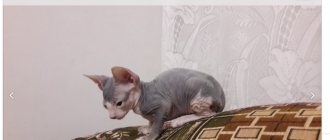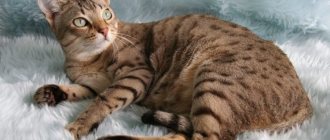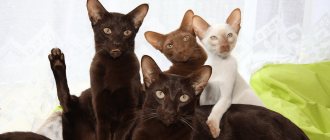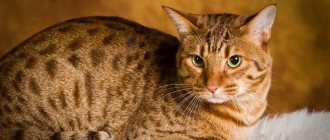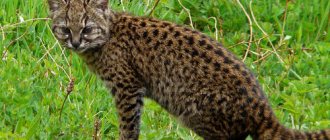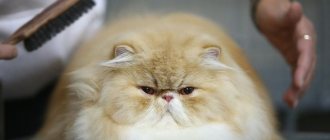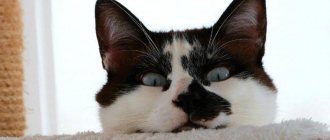Origin story
The Kanaani breed (also called Canaani) belongs to the group of experimental breeds.
It was officially registered quite recently - in 2001 in Israel, and its creator was generally far from the world of felinology. Doris Polachek was a successful sculptor and loved cats. She groomed and cherished all the animals that came into her house; the cats quickly got used to it and became completely tame. Except one. The steppe Libyan cat was wild and capricious. Doris spent several months racking her brains about how to earn the trust of this unbending son of nature, but in the end she decided to take a roundabout route.
She introduced him to an easy-going domestic cat. The litter was numerous, but every single kitten took after their father in character - they hissed, bit and flatly refused to communicate with humans.
But Doris also decided to follow the principle. The steppe cat was devilishly beautiful and graceful, and this species was considered endangered at that time - the woman wanted to leave this beauty for posterity. After reading a lot of literature and talking with experienced breeders, she introduced several more breeds into the experiment: Bengal, Abyssinian, and Oriental shorthaired representatives of the feline world. The breed was officially bred in 200, at the same time a standard was drawn up and registration with the FCI was issued. In 2009, the breed was recognized by the WCF.
Since 2009, it has been prohibited to cross other breeds with Kanaani cats (the breed has received closed status).
Character of cats and cats
In the character of the Kanaani cat, you can see the traits of domestic animals and its wild ancestors. This is a freedom-loving animal, self-sufficient and independent. She gets along well in the house for a long time, but can adapt well to any family, while treating all members equally.
If the Kanaani cat is in a good mood, she willingly plays, caresses, and purrs loudly. Cohabitation with other animals largely depends on the character of the neighbor and is very difficult to predict.
Kanaani is suitable for people who are often away from home for a long time. This is also an ideal cat for people who value independence and a wild disposition. Although, despite all its detachment and demonstrative attitude towards the family, showing who is the real boss here, it is a rather peaceful and tolerant animal. Although they definitely won’t put up with a bad attitude.
Kanaani cats are smart and quickly understand what people ask of them. If you decide that you need to show your pet who is boss, then this is not the case. This is a rather vindictive creature and, among other things, out of spite it will resist what it does not like. Therefore, if you need to accustom your Canaani pet to a litter box or scratching post, do not use the coercion method. Better try a casual game form. Reward your predator with praise and tidbits for every correct action. Usually, with this attitude, the animal willingly agrees and does what is required.
But things are not always so smooth. Sometimes, in order to achieve mutual understanding, you have to show restraint. Therefore, if you decide that your cat will be a Kanaani, be prepared for a “war” for the heart of the little savage. But if you win, your prize will be a reliable, affectionate and endlessly loyal friend.
One of the most important aspects of Canaanite education is early socialization. Therefore, when choosing a pet, be sure to check this point with the breeder. Otherwise, you risk acquiring an unsociable and unsociable animal, always hiding from people.
Standards
Kanaani are quite large cats. Males weigh 6-8 kg, females - at least 4.
| Standard | Description |
| Head | The skull is triangular and wide. The forehead is convex, the cheekbones and chin are clearly defined (there is no pinch). There is a noticeable stop on the nose. The ears are vertical, set wide, and pointed at the tips. The presence of a pattern on the outside and small tassels is considered a “plus”. The neck is muscular, long, graceful. |
| Eyes | Almond-shaped, large, widely spaced. A slight tilt is allowed. The standard color of the iris is green (a barely noticeable yellow tint is allowed). |
| Torso | Slender, with strong bones. The muscles are well developed. The limbs are long and slender. The paws are long, the toes are elongated, and the pads are dark. |
| Wool | The coat is of medium hardness and fits tightly to the body. The hairs are long, so the ticking of both the pattern and the main color is clearly visible. The undercoat is small. |
The breed has great success in Israel, as well as in Germany, where, in fact, the official standard was developed. There are several nurseries in the USA and several European countries. In Russia, Belarus and Ukraine there are no nurseries engaged in breeding Canaani, but animals can be purchased through Ocicat and Savannah breeders.
Description of Kanaani
global $ads_google; //data-ad-slot=”2475549904″ $ads_google = empty($ads_google) ? false : true; ?> if ($ads_google == false) {?> $ads_google = true; ?> } ?>
Most Kanaani cats are medium in size and their weight ranges from 4 to 6 kg.
But sometimes you can find larger individuals, whose body weight reaches 8 kg. The international felinological organization from Germany WCF has developed and adopted a breed standard, compliance with which allows the animal to be considered a purebred. This means taking part in breeding.
- Head
It is of medium size and is a wide triangle with a convex forehead. The cheekbones are clearly visible on the muzzle, but there is no pinch. The stop of the nose is soft, the chin is well developed.
- Ears
When looking at a representative of this breed, they create the feeling that he is excited or wary about something. This impression is due to the fact that the large ears are set wide on the head, and their tips are pointed. The presence of tassels at the ends and a distinctive pattern on the back surface are welcome.
- Eyes
large in size, shaped like an almond. Their seating position is wide and there may be a slight slope. In adults, the eye color is only green, although the standard allows for an admixture of a yellowish tint.
- Body
slender, with well-developed muscles and a moderately long neck. The animal's movements are graceful.
- Tail
In
cats, the kanaani is long. At the base its diameter is quite large, but gradually decreases towards the end. - Paws
Representatives of this breed have long, well-developed tails. The black pads are oval shaped. It is noteworthy that the gait of the animals is very similar to the gait of their wild ancestors.
- Short wool
fits tightly to the body. It cannot be called soft. There is very little undercoat. Despite the short length of the hairs, you can see the presence of ticking, which makes the pattern look somewhat blurry.
The breed standard allows for different colors of the animal, for example, beige and chocolate. There are two colors - primary and secondary. According to the rules, Kanaani cats have either a spotted or marbled pattern. The outlines of spots and stripes may be slightly blurred due to ticking. The only color that is considered a defect is silver.
Much attention is paid to the tail. There must be rings on it, and the tip must be black. The neck is decorated with a ring. The letter “M” clearly appears on the forehead. The nose is red and has a border of color corresponding to the color.
Colors
The Kanaani also inherited their fur color from their wild ancestors: all shades of beige, sand and brown. Dark spots of varying degrees of contrast are always tracked on the body. There is a pattern in the forehead area - the letter “M”, on the tail there are 3 rings, and there is one ring on the neck.
Defects:
- Similarity with oriental.
- Silver coat color.
In the photo there are cats of the Kanaani breed of popular colors
Character
Kanaani ( Hanaani ) is a self-sufficient cat; following its owner with its tail is not a royal thing. The character of the Kanaani reflected features of both wild ancestors and domestic ones. This is an independent and freedom-loving animal. It is necessary to seek a common language with this cat, sometimes long and patiently. When in a good mood, Kanaani love to play and cuddle, while purring loudly.
They adapt well to any family, do not establish hierarchical relationships, treat all family members equally, without preferring one owner. They have nothing against other animals in the house. They quickly get used to walking on a leash. It is not recommended to let a cat outside without a leash and without supervision - there is a high probability of escape.
Kanaani are unpretentious in food and do not require any special care. They are distinguished by good health and live quite a long time.
____________________________________________________ _______________________________________________
Character and behavior
Kanaani are completely independent animals and, as they say, love to walk “by themselves.” They are absolutely not afraid of loneliness and will not make a mess in your apartment if you decide to leave for a long time, or scream heartbreakingly under the bathroom door when you go there with the intention of spending an hour in warm water with a book in your hands. Kanaani is absolutely alien to intrusiveness, but cats of this breed will not tolerate either intrusiveness or disrespect towards themselves. They are very stubborn and independent, proud and love to be in first place.
However, all of the above does not mean at all that the Kanaani are ungracious bores and aggressive brawlers. Not at all. Kanaani accept the rules of the place where they live. They know how to show affection and attention to a person; they also expose their heads for affection and their bellies for scratching, like other cats.
But sitting on your hands for many hours is definitely not for them. And they won’t allow themselves to be dragged from corner to corner. Cats are quite tolerant of children, but if a child hurts him, he will not hide his displeasure. And this can frighten a child. Therefore, do not leave babies and cats alone, and explain to older children that a living creature requires careful treatment.
Kanaani are active animals. In a small apartment filled with furniture, the cat will feel uncomfortable, nervous and angry. Kanaani love space, fast play, jumping and running. Therefore, your task is to arrange a special play corner for your pet (you can do this in the garden if the climate of your area allows you to walk your cat all year round). Stairs, voluminous pipes, levels at different heights - all this will help the cat spend energy and be in a great mood.
Kanaani get along well with other cats and even dogs. They do not seek to divide territory, conflict or get involved in fights out of nowhere; moreover, they are often the first to take the initiative to make friends with another living creature.
But cats are not so kindly disposed towards birds and rodents: parrots, hamsters and other small animals awaken in them exclusively hunting instincts.
Kaannies love the outdoors, so you will have to walk them more often than any other member of the cat family. Accustom your pet to a leash or harness from early childhood, then you will not have problems with it in the future.
Kanaani are very curious creatures. This is especially true for kittens. Closed doors, boxes, shiny objects, humming mechanisms, burning candles and the like immediately create a desire to touch them with your paws or nose. Which, of course, is fraught with huge troubles, including serious injuries. Therefore, in advance, hide away all sharp and cutting objects, wires, medicines and anything that could pose a danger to little fidgets. For adult cats, open windows and vents pose a danger: in the heat of excitement, your pet can jump from the windowsill and crash.
Nutrition and health
They are not picky when it comes to nutrition, but the optimal choice would be a complete diet for active super-premium or holistic cats. Kittens up to one year old are fed 3 times a day, selecting food according to age. After 8-9 years, you can switch to a diet for older cats. Kanaani are not prone to overeating and lead an active lifestyle, so feeding with free access is acceptable.
There is no data on breed diseases or possible health problems. This is due to the fact that the breed is very young. But this does not mean that an animal cannot suffer from many other infectious and non-infectious diseases if it is not kept and fed properly. Life expectancy is 13-15 years.
Care instructions
Human care products are not suitable at all. First, acidity levels are very different between animals and humans. Using your favorite shampoo can cause your cat's skin to become irritated, dandruff, and itchy. And secondly, by licking off the remaining water (and unwashed shampoo that may remain), the cat can develop a banal stomach upset, and in some cases, serious poisoning.
When choosing shampoo, toothpaste, etc., buy a product with a neutral aroma (or without it at all), with a simple and understandable composition, without additives or dyes. Goodman and Bioflor have proven themselves well.
Wool
There are no particular difficulties in caring for Kanaani. They should be combed once a week with a regular brush with natural bristles (during the molting period - 2 times a week), and the remaining fur should be removed with wet hands.
Bathing
Kanaani not only don’t like to bathe, they hate bath procedures, so you should bathe them only if the cat is unable to wash itself. In all other cases, it is quite possible to get by with wet wipes without alcohol and fragrances.
Claws
There is no need to trim the Kanaani's claws - they can handle them just fine on their own. Provided you choose a good scratching post! But you will have to take special care of your ears and teeth.
Do you trim your pet's nails?
Yes, he’s lazy with us. No, he sharpens himself.
Ears
Inspect your ears every week, remove wax and dirt with a cotton swab dipped in ear lotion or chlorhexidine.
Teeth
It is important to brush your teeth every week: this will save both the teeth and gums.
A Kanaani kitten can only be bought abroad: in Germany, Israel or the USA. There are no nurseries or private breeders on the territory of our country or the CIS countries. The cost of one individual is approximately 60-80 thousand rubles, plus add transport costs to this.
Care and maintenance of Kanaani
global $ads_google;
//data-ad-slot=”2475549904″ $ads_google = empty($ads_google) ? false : true; ?> if ($ads_google == false) {?> $ads_google = true; ?> } ?> Caring for Kanaani cats is quite simple. They have very little undercoat, so they practically do not shed. A standard set of procedures is enough for them: brushing once a week, periodically cleaning the ears using a special lotion and washing the eyes.
They are quite unpretentious in nutrition, but in order to maintain the health of your pet, you do not need to use its “omnivorousness”. It is not recommended to put in a bowl what is on the depleted table, which some owners do to save money. Salty and sweet foods, as well as fatty foods, are strictly prohibited. All this can cause kidney, liver or stomach diseases.
On average, Kanaani cats live up to 15-17 years.
It is better to try to provide your Kanaani cat with a complete and balanced diet, which includes proteins and carbohydrates, vitamins and beneficial elements that promote the growth and development of the animal. You can buy ready-made food, but only premium products will be beneficial for the body. It is important not to overfeed the cat.
Diseases of Kanaani cats
This breed is quite “young”, so there are no extensive statistical data on hereditary diseases. Based on the presence of Bengal genes, we can conclude that there is a tendency to develop cardiomyopathy, a dangerous heart disease. The stomach is also at risk, so it is important to provide the correct diet for your pet. Don't forget about vaccinations and preventive examinations at the veterinarian.
Conclusions about the breed
global $ads_google;
//data-ad-slot=”2475549904″ $ads_google = empty($ads_google) ? false : true; ?> if ($ads_google == false) {?> $ads_google = true; ?> } ?> The Kanaani cat is a charming pet. Watching his graceful movements and fun games is a pleasure. But potential owners should be prepared for the fact that the animal may from time to time display a cool disposition and an independent character. However, such obstinacy is easily overcome with care and affection.
It should be noted that nurseries breeding this breed are located mainly in Israel, the USA and Germany, so purchasing it may be difficult.
Catering
When it comes to food, Kanaani cats are omnivorous and undemanding, however, there are specifics in their feeding.
Feeding an animal what you eat yourself is dangerous. Of course, if you remember the village Murziks, who crack both their cheeks for cabbage soup, porridge, and fried pork, a reasonable question arises: why do they look so healthy and well-fed with such an unhealthy diet? Outwardly, they may look good, but illnesses overtake them early, and they live much less than they could. Therefore, if you want your cat to live longer, you will have to either cook him a specific menu or buy high-quality food.
Natural products
The natural menu consists of 80% meat and offal. These are beef, veal, rabbit, turkey and lamb, minced chicken necks, liver and kidneys, stomachs and hearts. Cats should not be given lard and bones (even boiled), smoked, fatty and fried meat.
Fish (sea fish, cleaned of bones) is given no more than 2 times a week (so as not to provoke the development of kidney diseases). Porridge - every day. They are cooked from buckwheat, rice or oatmeal, in water, adding a little milk for taste. 3-4 times a week, include stewed or boiled vegetables (carrots, beets, pumpkin, zucchini, green salad, herbs) and dairy products (cottage cheese, sour cream, kefir, yogurt, cream, natural yogurt) in your menu.
Strictly contraindicated:
- Floury.
- Spicy.
- Salty.
- Sour.
- Roast.
- Smoked.
- Dried.
- Sweet.
Expert opinion
Dusheba Vera Ivanovna
In 2010, she graduated from the Moscow State Academy of Veterinary Medicine named after K.I. Scriabin with honors, specializing in veterinary medicine. I regularly attend veterinary conferences, congresses, and webinars.
Food should not be salted, peppered or added to it with any spices, mayonnaise or ketchup. Chocolate, eggplant and avocado are real poison for cats; potatoes and legumes cause fermentation in the intestines and discomfort.
Recommended food
High-quality food is not economy food, which is full of store shelves. A minimum of useful food additives and vitamins, corn gluten (a strong allergen), waste instead of meat - all this does not benefit the animal’s body. Premium food is slightly better in composition, but overall does not provide the cat with enough nutrients. Therefore, if possible, buy super-premium and holistic food from the Naturea, Mealfeel, Pronature Original, ProSeries, Sanabelle, Now Fresh groups.
Below are recommended super-premium foods. Links with the names of the food are clickable, on them you can, within our website, get acquainted with the descriptions of the food and read reviews from owners of Kanaani cats.
| Holistic | Super premium | Holistic |
| Orijen | Natyka | Nutram |
Your cat should always have access to clean drinking water at a comfortable temperature (neither cold nor hot). You can buy it in a store, clean it with a filter, or leave it in a saucepan without a lid for several hours.
Kanaani cats
- Standard
- Photos
- Video
- ads
- Comments
One of the many attractions of Israel is the Kanaani cat. This is a very young breed, which was officially registered in 2000. This is a very freedom-loving and independent beautiful creature. By the way Kanaani behaves, one can say that she has a royal character. People who are rarely at home can safely get such a pet, because the Israeli cat does not suffer from loneliness, and sometimes wants to be alone.
Israeli breeder Doris Pollacek, while breeding the Kanaani breed, tried to achieve similarity with a wild cat. The work used the genes of many oriental cats, but in the end the first Kanaani kittens appeared from crossing a short-haired domestic cat and a Libyan steppe wild cat. The result exceeded expectations, the new breed inherited the wild beauty of the Libyans, and from the domestic cat - a tolerant attitude towards the hearth and its owner. Kanaani is called the calling card of Israel; this creature is very popular in this country, but is still rare outside its borders.
Appearance of Kanaani cats
Representatives of the Kanaani breed are distinguished by their large size, but when looking at this creature with its wild beauty, it is impossible to resist noticing the elegance of the Israeli cat. The weight of adult cats can reach 6 kg. Kanaani's physique is very beautiful, the animal's body literally plays with its muscles. The legs are long, slender, with well-developed muscles; it seems that this animal is capable of running at the speed of a cheetah and jumping with the capabilities of a jaguar. This is partly true, Kanaani is a real athlete and outperforms most representatives of the cat kingdom in this regard. The tail is wide with a pointed tip, it cannot be called short, it is of medium length.
The head with a rather wide skull is triangular in shape. The ears are set wide, very large, triangular in shape. The tips have tassels, like those of a small lynx. The chin is strong-willed, like that of animals with a strong character, and the cheekbones are expressive. The eyes are set slightly askew, they are very large and almond-shaped. The look of this wild beauty pierces through and through, their rich green color gives the animals a touch of mystery. Adults may have a yellowish tint to their green eyes.
The Israeli cat's fur is short, close to the body, there is practically no undercoat, and it feels hard to the touch, like its steppe ancestors. Kanaani’s “fur coat” was inherited from her wild ancestors. The main color tone can range from cream to cinnamon. On this light background there are dark spots: chocolate, black with a brown tint, dark cinnamon. According to the standard, marbled and spotted patterns are allowed. There is also a slight ticking on the hairs; it should not reduce the sharpness of the spots. A distinctive feature of the breed is its color - a necklace around its neck. The tail at the end has several stripes that seem to ring it.
Character of cats of the Kanaani breed
It’s not for nothing that Kanaani’s owners say that the character of this pet is truly royal. They behave with dignity and manage to make it seem like a person was simply created to care for, feed and caress these proud beauties. These creatures are too independent and do not fawn on anyone, begging for food or affection. Their wild temperament is harmoniously combined with royal calm and poise. This cat will not follow its owner as if tied, it has its own affairs, it does not participate in the owner’s. If Kanaani is not in the mood, then it is better not to approach her, but if the mood is at the highest level, then the wild beauty plays with pleasure, caresses her, and her loud, contented purring is constantly heard.
A person who decides to place an Israeli cat in his home must prepare for the fact that he will have to earn her trust, and then love. It is unacceptable to punish this creature with the genes of a steppe cat; Kanaani will never allow himself to be insulted and will not tolerate insults. This cat is vindictive and can even take revenge on his offender some time after the conflict. At the same time, having achieved mutual understanding with such an intellectually developed pet, you can easily teach him some tricks that the animal quickly remembers. A cat with the character of a royal person will definitely try to dominate other pets; if the response is disobedience, then fights for first place in the house are quite possible.
Caring for Kanaani cats
The most important thing in caring for Israeli cats is giving them the opportunity to walk as much as possible. If the walk takes place on the street, then a collar and leash are required, since freedom simply boils in Kanaani’s blood and he can easily run away, forgetting about the owner. When the cat is in the lady, then, again, her freedom should not be limited. She cannot stand it when she is locked up, the cat behaves like the mistress of the house and wants to go where she pleases.
Regarding coat care, Kanaani completely handles the combing themselves and diligently keeps their “coat” clean. This cat is very clean and tidy. To remove dead hairs and simply give your pet a pleasant massage with a brush, it is recommended to comb the animal once every 9-10 days. A bath day is held once a month, you can bathe your pet less often, it depends on the need and how your pet reacts to water procedures. If he doesn’t like getting wet in water too much, then there is no need to force him to do it often.
Be sure to regularly examine and brush the animal’s teeth, remove excess wax from the ears and wipe the eyes and tear ducts with a damp swab. From time to time, as needed, the cat's claws are trimmed.
Nutrition for Kanaani cats
The owner chooses the method of feeding Kanaani, but before the kitten gets into your home, you need to find out what he ate from the previous owner. The transition to a new feeding method should be smooth and careful. You can use the easiest option - ready-made cat food. In this case, you need to purchase only premium ones and ensure your cat has 24-hour access to fresh water.
When feeding natural food, Kanaani’s diet must include lean meat and seafood. In addition, the menu includes porridge, vegetables (except potatoes), low-fat fermented milk products. In addition, provide your pet with vitamin and mineral supplements.
An adult Israeli cat needs to be fed twice a day, and it is necessary to adhere to a certain regimen and teach the cat to eat only at certain hours. It is strictly forbidden to treat Kanaani with leftovers from your lunch or simply share your food with him.
Health of Kanaani cats
If you take good care of a Kanaani cat, feed it according to all the rules, and regularly show it to a doctor for preventive examinations, then it will live to the delight of its owner for up to 15 years. The ancestors of the Israeli cat had good health, and she inherited the same health. Kanaani does not suffer from chronic diseases, she has no genetic health problems, in a word, she can well be considered a hardy and healthy long-liver. The necessary vaccination must be carried out on time, so as not to once again expose your pet to the danger of “catching” something bad on the street.
Country of origin of the Kanaani breed
Kanaani breed standard
Kanaani Body: Medium to large, light body type, elegant yet strong and muscular. The limbs are long, slender, the paws are oval. The tail is long, somewhat wider at the base, and ends sharply.
Head of the Kanaani breed: On a slender, long neck, it forms a wide triangle, emphasized by large, widely set ears. The distance between the ears is not less than the width of the base of the ear. There is a flat surface between the ears. Noticeable cheekbones, but no punch. The slightly convex forehead blends smoothly into a distinctly straight nose. The muzzle is slightly flattened and the chin is strong.
Kanaani breed eyes Large, almond-shaped. Set wide, at a slight angle. In adult animals, the eye color is green; yellow-green is acceptable.
Kanaani breed ears Large, wide at the base, pointed. They stand wide and upright. Tassels are desirable, a spot of wild color is a must.
Kanaani breed coat Short, close, with a slight undercoat. The texture is rough, unlike the soft fur of a Siamese cat. The hairs are of sufficient length to have distinct ticking stripes both in the design and in the main background. Ticking is required, but it should not be so strong that the spots blur.
Colors of the Kanaani breed: The background is from light beige to cinnamon, the spots in the pattern are black-brown, chocolate or cinnamon. The sharpness of the drawing is softened due to ticking. The spotted and special marbled pattern is recognized. Silver varieties are not allowed.
Disadvantages of the Kanaani breed: Too much similarity to the Oriental.
Diseases
This breed is young, so no genetic faults have been identified yet. But some nuances are worth considering.
Firstly, since the Kanaani have Bengal cats as ancestors, it is implied that some ailments from them were inherited by the Kanaani. Namely, a tendency to hypertrophic cardiomyopathy.
This pathology is as follows: the volume of the heart chambers decreases, which leads to heart failure and sudden death. Many do not live to old age. Symptoms: the cat loses interest in active games, it breathes heavily, suffers from attacks of suffocation, the mucous membranes become bluish, and ascites and paralysis of the lower extremities often occur. The disease cannot be cured, but symptomatic therapy can improve the quality of life and prolong it.
The second problem is a weak stomach. An unbalanced diet, food from the human table, and low-quality ready-made food cause serious problems in Kanaani cats: enteropathy, colitis, gastritis, and intestinal inflammation. Therefore, the diet of Kanaani cats should be monitored very carefully from childhood.
And, of course, preventive vaccinations need to be given, as well as deworming once a quarter.
Historical reference
The Canaan cat or Kanaani is a descendant of the Steppe spotted cat, which has lived on our planet for more than 10,000 years. It was the Steppe cat that was tamed by humans in ancient times and from it almost all aboriginal breeds originated, including the wild Libyan cat, which participated in the breeding program for breeding Kanaani.
This is incredible! More than 979 unique DNA pairs are derived from mutations and crosses of the Steppe cat and other representatives of the cat world.
Israeli resident Doris Polachek, who lived in the company of three castrated cats, occupied a high position, but was not a geneticist, breeder, breeder or even breeder. An ordinary person living a daily routine can change the world and Doris is direct proof of this statement.
The woman was partial to domestic predators; she picked up three of her cats on the street and took them out. Doris again could not ignore the misfortune of her “little brother” and took custody of a weak, small but charming kitten. However, it quickly became clear that Doris's new ward was none other than the wild Libyan cat. By the age of six months, the baby showed a wild disposition and a very bad character for a domestic cat.
Imagine that you found an Ocelot or a Pallas cat in the kitten you picked up, what will you do? The logical thing to do is hand the animal over to a wild cat specialist, but that’s not Doris Polachek’s case. The woman fell so in love with the appearance of the “harmful pet” that she decided to get offspring from him at any cost. The mating took place with the expectation that the babies would be born affectionate and domestic, but as beautiful as a wild Libyan cat. Nature took its course, and Doris received kittens as wild and quarrelsome as their “dad.”
Photo gallery
Below are photos of cats of the Kanaani breed.
katniss_khaleesi
ajit.sp
ryoko_aniroshi
alinahoskins_art
Health Features
Cats can suffer from diseases of the gastrointestinal tract. For this reason, it is worth paying due attention to the animal’s diet. To reduce the risk of chronic, protracted diseases, you should not neglect visits to the veterinarian and conduct a full examination of your cat once a year. Life expectancy is 15-20 years. The cat is considered a relatively young breed, so detailed information about common genetic diseases has not yet been obtained. However, if you look at its close relatives - Bengal cats, then there may be a tendency to cardiovascular disease - cardiomyopathy.
Definition of the Kanaani breed
Kanaani belong to large and medium-sized cats, the significance ranges from four to eight kilograms.
The WCF organization, which formally recognized these cats, gives the following description of the breed in terms of standards:
- The head is medium in size, triangular in shape, with prominent cheekbones. The nose, in comparison with the muzzle, is slightly protruding, the nose is absolutely straight, the chin is angry.
- The ears are large, set far apart from each other. The cornerstone is wide, with pointed tips. Ideally, there should be secondary tassels and a “print” pattern on the back of the ears.
- The seeds are large in size and almond-shaped. They have a slight slope and a wide fit. What's the matter? As for the Oriental Kanaani, their eyes do not meet the normal standards. The color is exclusively green. Deviation is allowed if only yellow is present along with green.
- The body is athletic, muscular but graceful. The neck has a length proportional to the entire body.
- The paws, both front and rear, are long, with oval pads. Following their natural gracefulness, their gait resembles that of wild cats.
- The tip is elongated, of good thickness, which tapers towards the end.
- The wool is medium coarse, short in length. The coat fits tolerably tightly and has a small undercoat. The length of each hair allows you to see the ticking of the underlying pattern. However, this does not affect the patterns in the form of spots, which should be as clear as possible.
READ Yorkshire Terrier mix: photo, mix with Chihuahua, mix with Spitz, Dachshund, Jack
What is Kanaani?
These cats and cats are an experimental breed that was artificially bred at the end of the 20th century. The essence of the transformation was to create a domestic cat that looked like a wild forest cat.
As a result, we got a noble animal, which is often compared to the most beautiful representatives of the cat world.
History of the breed
The emergence of the Kanaani breed is inextricably linked with the name of the Israeli Doris Polachek. The girl was far from felinological and breeding activities. She worked as a sculptor in Israel and Russia. But I always loved cats. She was the happy owner of three purrs.
Doris decided to take matters into her own hands and crossed a wild cat with a domestic cat. The offspring did not live up to expectations. Outwardly they were also beautiful, but their character left much to be desired. The genes of the male cat turned out to be stronger; predatory habits and aggression predominated in the kittens.
Then Polachek began to study thematic literature and collaborate with the “Ha Jerushalmi” nursery. Hard work began on developing a new breed. During the selection, Orientals, Abyssinians and Bengals were involved.
In 2000, Kanaani were recognized by the felinological association FCI. In 2008, the German organization WCF assigned official status to the breed and prohibited crossing Kanaani with other cat breeds.
Canaani owes its name to the historical biblical area, the former Palestinian province of Canaan. Known from Holy Scripture as the Promised Land. Therefore, both names are equivalent for the breed: Kanaani and Canaan. In both cases it will be correct.
Pros and cons (for whom it suits)
In terms of character, Kanaani are not much different from other breeds bred with the participation of wild species. They are suitable for those people who love independence and wildness in the character of their pet. Kanaani cannot be classified as one of those cats that will follow on the heels of family members, although if the cat is in a good mood, then it may well approach the owner in a friendly manner and cuddle. Sometimes they purr too loudly. They can be kept in a city apartment or in a country house, but it is not recommended to leave them unattended. If you decide to have such a pet in a city apartment, learn to walk it on a harness or leash, and on the site of a country house it is recommended to build a large enclosure, since Kanaani love to hunt birds and other small animals.

